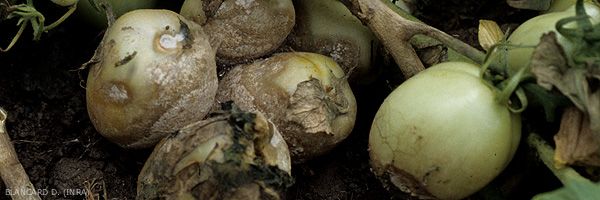
Thanatephorus cucumeris
(A.B. Frank) Donk (1956)
Rhizoctone brun
(A.B. Frank) Donk (1956)
Rhizoctone brun
- Classification: Fungi, Basidiomycota, Cryptomycocolacomycetes, Incertae_sedis_, Cantharellales, Ceratobasidiaceae
- synonymie : Rhizoctonia solani J.G. Kühn (1858)
- English names: damping-off, fruit rot
Thanatephorus cucumeris ( Rhizoctonia solani ) is widespread worldwide and widely reported in all tomato growing areas. As we suggested earlier, it is capable of infecting several hundred different hosts. On tomatoes, this soil fungus is especially known to cause damping off in nurseries, root lesions and cankers on the crown, alterations on the stem and on the fruits. The symptoms it causes can be observed in all types of production, from the most extensive to the most intensive crops, both in open fields and under cover and more in soil than in soil.
In France , it causes damping-off, especially in extensive nurseries. It is frequently observed on tomato roots, alone or in association with other root pests such as Pyrenochaeta lycopersici , Colletotrichum coccodes and root-knot nematodes belonging to the genus Meloidogyne. Lesions on the neck and on the fruits of tomatoes intended for industry are also attributed to it. It is considered to be a biological marker for “tired” market garden soils which have repeatedly borne tomato and / or other sensitive vegetable crops. For several years it has been part of the complex of telluric pests attacking the roots of rootstocks cultivated under cover, in particular with C. coccodes , Phytophthora nicotianae , several species of Meloidogyne and Globodera tabacum .
Much work has been done on this fungus in ubiquitous and polyphagous order to characterize the diversity of its strains. Indeed, these differ among other things by their cultural characteristics, their pathogenicity and in particular their host specificity. Among the differentiation criteria studied, their anastomosis affinities have made it possible to establish more than ten groups (GA), and sometimes even subgroups. The knowledge at our disposal on the strains prevalent on tomato is still limited.
Despite this, a few strains belonging to anastomosis groups different have been characterized on this nightshade. This is the case of strains belonging to the groups AG-2-1, AG-3, AG-4, AG-4 subgroup HG-1, AG-5 The AG-2 group, divided into several subgroups, includes relatively specialized strains on Brassicaceae (AG-2-1) or on maize and on sugar beet (AG-2-2). The strains belonging to AG-4, also subdivided, with Thanatephorus pratola as teleomorph, are rather polyphagous when temperatures are high. Remember that the strains of the AG-3 group are often specialized on Solanaceae.
- synonymie : Rhizoctonia solani J.G. Kühn (1858)
- English names: damping-off, fruit rot
Thanatephorus cucumeris ( Rhizoctonia solani ) is widespread worldwide and widely reported in all tomato growing areas. As we suggested earlier, it is capable of infecting several hundred different hosts. On tomatoes, this soil fungus is especially known to cause damping off in nurseries, root lesions and cankers on the crown, alterations on the stem and on the fruits. The symptoms it causes can be observed in all types of production, from the most extensive to the most intensive crops, both in open fields and under cover and more in soil than in soil.
In France , it causes damping-off, especially in extensive nurseries. It is frequently observed on tomato roots, alone or in association with other root pests such as Pyrenochaeta lycopersici , Colletotrichum coccodes and root-knot nematodes belonging to the genus Meloidogyne. Lesions on the neck and on the fruits of tomatoes intended for industry are also attributed to it. It is considered to be a biological marker for “tired” market garden soils which have repeatedly borne tomato and / or other sensitive vegetable crops. For several years it has been part of the complex of telluric pests attacking the roots of rootstocks cultivated under cover, in particular with C. coccodes , Phytophthora nicotianae , several species of Meloidogyne and Globodera tabacum .
Much work has been done on this fungus in ubiquitous and polyphagous order to characterize the diversity of its strains. Indeed, these differ among other things by their cultural characteristics, their pathogenicity and in particular their host specificity. Among the differentiation criteria studied, their anastomosis affinities have made it possible to establish more than ten groups (GA), and sometimes even subgroups. The knowledge at our disposal on the strains prevalent on tomato is still limited.
Despite this, a few strains belonging to anastomosis groups different have been characterized on this nightshade. This is the case of strains belonging to the groups AG-2-1, AG-3, AG-4, AG-4 subgroup HG-1, AG-5 The AG-2 group, divided into several subgroups, includes relatively specialized strains on Brassicaceae (AG-2-1) or on maize and on sugar beet (AG-2-2). The strains belonging to AG-4, also subdivided, with Thanatephorus pratola as teleomorph, are rather polyphagous when temperatures are high. Remember that the strains of the AG-3 group are often specialized on Solanaceae.





